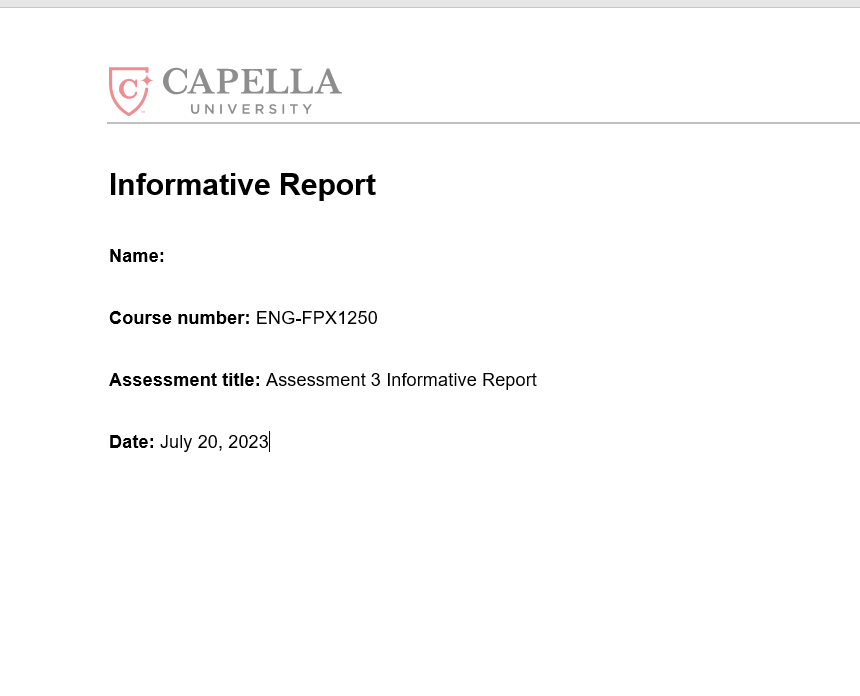Name:
Course number: ENG-FPX1250
Assessment title: Assessment 3 Informative Report
Date: July 20, 2023
Summary
With the increase in technological advancements, the healthcare sector is also changing in response. Chronic conditions such as diabetes, kidney failure, and heart conditions, reinforce the need for efficient and effective diagnosis and treatment. Telehealth is among the viable options that allow healthcare professionals and patients to exchange medical information across locations using audio and video platforms. The real-time interactions through e-mails, video conference, and other methods enhance communication and collective commitment to optimizing care outcomes. Some gains from the technology include reduced cost of care, interdisciplinary collaboration, and better patient education and self-management. However, risks such as privacy and security breaches, declining in-person care, and regulatory requirements undermine efforts to implement telehealth.
Risks and Benefits
Telehealth has several benefits and risks that influence the quality of patient care across continuum. One risk is data privacy and security breaches that expose protected health information to unauthorized access and information theft. Health information systems and communication tools used in telehealth are vulnerable to hacking, despite the integration of encryptions (Gajarawala & Pelkowski, 2019). The risk of patients and organizations losing sensitive information could trigger questions on long-term viability of the technology. Non-compliance with Health Insurance Portability and Accountability Act and other policies on data protection may reduce patients’ trust and confidence in an organization’s ability to prevent breaches.
A second risk is inadequate physical examinations that limit healthcare professionals and patients from accessing a comprehensive view of a disease (Gajarawala & Pelkowski, 2019). The limitations have adverse impacts on continuity of care compared to conventional practices that made it easier for care professionals to enhance the accuracy and adequacy of diagnosis and treatment. A third risk is multiple legal and regulatory barriers that trigger confusion within the clinical environment. The risk also causes misunderstanding and may require a facility to invest more in designing and implementing risk management strategies. The challenges also expose organizations to penalties that may have adverse implications on profitability. However, benefits associated with telehealth remind stakeholders to deliberate on whether the risks outweigh gains and vice versa.
One advantage is the ability to strengthen interdisciplinary collaboration through improved sharing of knowledge, skills, and experiences within and outside an organization. The technology boosts communication among primary care providers and specialists to make them more committed to delivering patient-centered and outcome-based care. The second benefit is improved patient education due to timely access to information on the nature of a disease, prognosis, and evidence-based treatment (Gajarawala & Pelkowski, 2019). The process helps patients embrace self-management to prevent unnecessary emergency care visits, increased spending, and hospitalization. Further, telehealth reduces the cost of health care services. Patients in remote and rural areas can utilize the technology for patient monitoring. In this case, the group do not require frequent travels for in-person visits.
Risk Detail
Information security and privacy breaches is a serious concern that undermine viability of telehealth. Legislations such as the Health Insurance Portability and Accountability Act and Children’s Online Privacy Protection Act indicate the need for healthcare providers to pay attention to protected health information (Gajarawala & Pelkowski, 2019). While there are standards and regulations to secure the platform, sophisticated cyber-attacks may cause unauthorized access to data during transmission and storage.
The risk creates the impression that patients have limited control of their own data, the telehealth apps may not be HIPAA compliant, and remote care presents multiple security risks. The challenges indicate the need for a multi-factor authentication to restrict access and intrusion through malware. Layered security reinforces efforts to meet data privacy, confidentiality, and security compliance requirements (Burroughs et al., 2021). Increased investment in reinforcing security and privacy measures could limit smaller organizations from embracing telehealth. As such, sustainable depends on efforts to identify and intercept risks using human, technical, and administrative solutions.
Benefit Detail
A key benefit of telehealth is that it reduces the cost of care. The technology protects patients and families from frequent emergency care visits, hospitalization, readmissions, and travels. For instance, the cost of palliative care reduces due to timely exchanges and patient monitoring to enable individuals understand their condition, progress, and prevention and treatment (Hwei & Octavius, 2021). Reduced in-person visits mean that patient do not need to travel longer distances and incur high cost of accessing primary care providers and specialists. Thus, significance savings are achievable through reduced number of emergency care visits since patients can access urgent care through a phone call or video consultations.
Physicians can access patients’ medical records online, which helps in diagnosis and prescription without the patient making in-person visits (Hwei & Octavius, 2021). Reduced travels to appointments means that the clinical team can improvement management of resources and manage activities to achieve the intended outcomes. Further, telehealth reduces costs of care by allowing greater access to specialists. For instance, telehealth may link a patient to a radiologist, since medical images are transferrable from a remote location. The cost-effectiveness nature of the technology may encourage more facilities to embrace advancements in technology that allow them to improve patient experiences.
Citations
Burroughs, M., Urits, I., Viswanath, O., Simopoulos, T., & Hasoon, J. (2021). Benefits and shortcomings of utilizing telemedicine during the COVID-19 pandemic. https://www.tandfonline.com/doi/full/10.1080/08998280.2020.1792728
Gajarawala, S., & Pelkowski, J. (2019). Telehealth benefits and barriers. The Journal for Nurse Practitioners, 17(2), 218-221. https://www.ncbi.nlm.nih.gov/pmc/articles/PMC7577680/pdf/main.pdf
Hwei, L. R., & Octavius, G. S. (2021). Potential advantages and disadvantages of telemedicine: A literature review from the perspectives of patients, medical personnel, and hospitals. Journal of Community Empowerment for Health, 4(3), 180-186. https://journal.ugm.ac.id/jcoemph/article/view/64247



